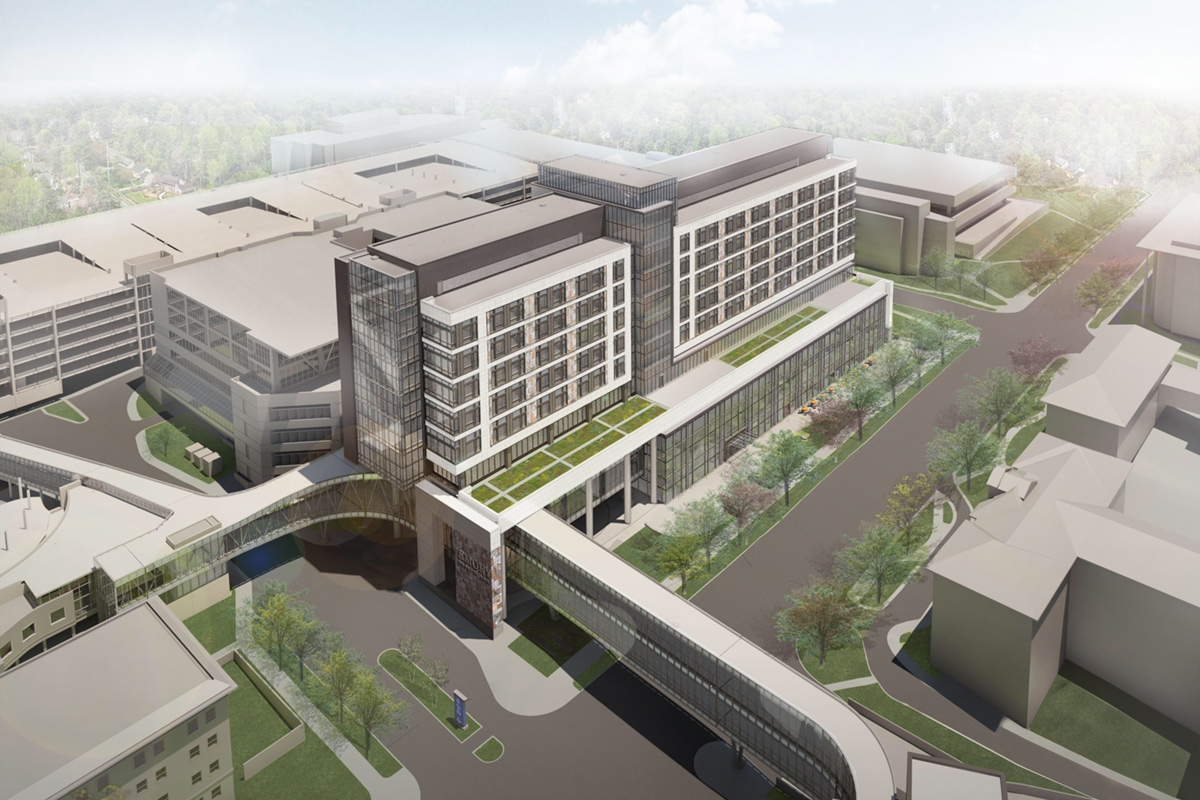Our Changing Campus
Growth supports community, sustainability

Rendering courtesy of SmithgroupJJR.
When more than four thousand Emory alumni and friends returned to campus for Homecoming weekend in September, some version of these words were uttered over and over: “Wow, I hardly recognize this place.”
Construction sites are such a fixture at Emory that it’s difficult to imagine the campus without them—all symbols of continued growth, improved quality, and increased sustainability for the university and Emory Healthcare.
Several key projects were completed over the summer, including Raoul Hall, Emory’s newest first-year residence hall, and phase II of the Candler School of Theology building, the new home of the Pitts Theology Library.
Named after Eleonore Raoul, the first woman to graduate from Emory School of Law and a lifelong supporter of equal rights for women, Raoul Hall opened with a community focus on social entrepreneurship. Residents will be encouraged to explore solving societal problems through creativity and innovation, employing organizations, faculty and community representatives, and educational opportunities.
Since 2006, Emory has opened new residence halls under a long-term freshman housing plan that links academic and residential experiences in living-learning communities rooted in themes such as citizenship, sustainability, leadership, and creativity.
“So much of what we do is about the push for building community across perceived boundaries, ensuring that every student has a sense of belonging,” says Ajay Nair, senior vice president and dean of campus life. “Everything is intended toward that goal, helping students to be successful and feel a sense of belonging and ownership.”
And the growth continues this fall. Here’s a snapshot of what’s under way.
Briarcliff Property
Site preparation has begun at Emory’s Briarcliff property for construction of a 55,000-square-foot Library Service Center, a joint project of Emory and Georgia Tech that will serve as an off-site library archive and processing center. Anticipated completion is fall 2015.
Chemistry Center Addition
A five-story, 70,000-square-foot addition to the Atwood Chemistry Center will create additional research and instructional space for the Department of Chemistry, while renovation of 40,000 square feet of the existing Atwood Chemistry Center provides labs, offices, and support space. The addition is slated for completion in May 2015. “The building project sits right in the middle of Emory’s growing science commons,” says David Lynn, chair of the Department of Chemistry. “It was important to all of us that the architecture have an open, welcoming feel. This space is a great opportunity to pull the sciences together.”
Oxford College Science Building
Featuring a classical design and modern amenities, the new science building at Oxford will include classrooms, wet labs, faculty offices and collaborative spaces for astronomy, biology, chemistry, geology, and physics. Anticipated completion is April 2016. “Having a science facility that can meet the needs of our thriving science curriculum has been a primary goal for a number of years,” says Oxford Dean Stephen Bowen. “The completion of this building will have enormous impact.”
Emory University Hospital Bed Tower
Construction continues for the new bed tower, located near Emory University Hospital on Clifton Road. The new tower will feature 450,000 square feet on nine levels, providing 210 patient beds as well as associated diagnostic and treatment spaces, ICU rooms, care units for cancer and transplants, and much more. Anticipated completion is 2017.
Emory Water Reclamation Facility
This facility will reclaim and process wastewater for nondrinking reuse in toilets and steam and chiller plants. It will include a 2,200-square-foot hydroponic greenhouse and 1,200 square feet of hydroponic wetlands to process up to 300,000 gallons of water per day, saving up to 146 million gallons of drinkable water annually. Construction is set to be complete by the end of 2014. “By using reclaimed water, Emory is modeling best practices in water conservation locally and globally,” says Ciannat Howett, director of sustainability initiatives. “Emory’s Water Reclamation Facility will relieve pressure on the local community’s aging and overtaxed water treatment system, reducing energy use impacts from treating and distributing water centrally, and helping the greater Atlanta region demonstrate responsible stewardship of one of Earth’s most precious resources.”
Woodruff Library Tower Level 10
University Libraries is renovating levels 9, 10, and 11 of the Woodruff Library as the permanent home of the Manuscript, Archives, and Rare Book Library (MARBL). This phase will renovate level 10 as the public face of MARBL, featuring an expanded reading room, interactive exhibit areas, technologically equipped classrooms, and gathering places. Renovation is scheduled to be complete next summer. “The project to expand and upgrade MARBL’s space and services is the culmination of many people’s efforts and dreams over the years,” MARBL Director Rosemary Magee says. “We’re thrilled with the opportunity to further strengthen one of Emory’s most distinguished and distinctive resources.”



